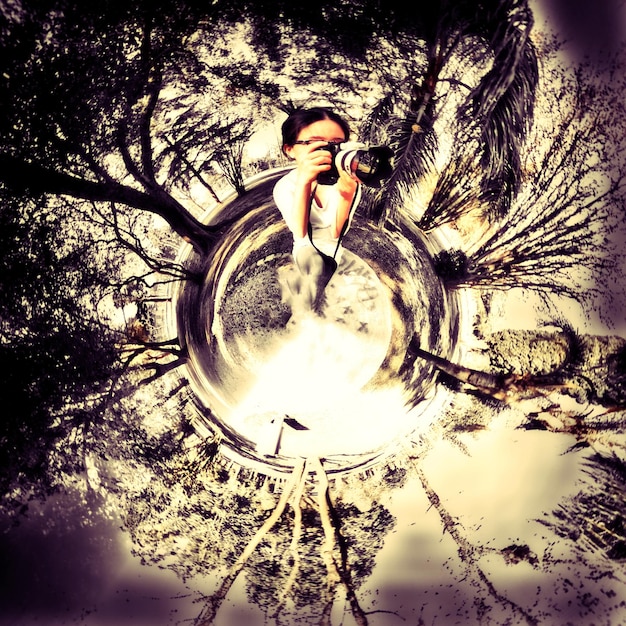Genre Bending: Exploring Movies That Defy Categorization

Anúncios
Genre bending occurs when films blend elements from different genres, creating unique and often unexpected cinematic experiences that challenge traditional categorization.
Anúncios
Have you ever watched a movie that felt like a blend of action, comedy, and romance? That’s likely an example of genre bending, a fascinating trend in cinema where films playfully mix and match elements from different genres.
What is Genre Bending?
Genre bending is a cinematic technique where filmmakers deliberately combine elements from different genres to create a new and often unexpected viewing experience. It’s about breaking free from the traditional constraints of single-genre storytelling.
Anúncios
This approach can lead to films that are unpredictable, innovative, and highly engaging, as they challenge viewers’ expectations and offer fresh perspectives on familiar themes.
The Purpose of Genre Bending
Genre bending isn’t just about mixing things up for the sake of it. It often serves a deeper purpose, such as commenting on societal norms, exploring complex themes, or simply offering a unique and memorable cinematic experience.
- Innovation: Genre bending pushes the boundaries of storytelling, leading to fresh and original ideas.
- Reflection: By blending genres, filmmakers can explore complex themes and reflect on societal issues in nuanced ways.
- Engagement: The unexpected nature of genre-bending films can keep audiences guessing and deeply engaged.
Ultimately, genre bending is a tool that allows filmmakers to be more creative and expressive, resulting in films that are both entertaining and thought-provoking.
Examples of Genre-Bending Films
Many films have successfully blended genres, creating unique and memorable cinematic experiences. Here are a few notable examples:
These movies showcase the versatility of genre bending, demonstrating how different genres can be combined to create something truly original.

“Shaun of the Dead” (2004)
“Shaun of the Dead” is a brilliant blend of horror and comedy, affectionately known as a “rom-zom-com.” The film follows Shaun, a man who is trying to get his life back on track amidst a zombie apocalypse.
“Cowboys & Aliens” (2011)
As the title suggests, “Cowboys & Aliens” combines the Western and science fiction genres. The film is set in the Old West and follows cowboys and settlers who must team up to fight off an alien invasion.
These examples illustrate how genre bending can create unique and memorable films by combining unexpected elements.
Why Genre Bending Works
The appeal of genre bending lies in its ability to subvert expectations, offer fresh perspectives, and create truly unique viewing experiences. But what makes it work so well?
When done well, genre bending can create films that resonate with audiences on multiple levels, offering both entertainment and intellectual stimulation.
Subverting Expectations
Genre bending often involves taking familiar tropes and conventions and turning them on their head. This can lead to surprising and delightful moments that keep audiences engaged.
Offering Fresh Perspectives
By combining different genres, filmmakers can explore complex themes and ideas from multiple angles, offering fresh perspectives on familiar topics.
- Surprise: Combining unexpected elements keeps audiences guessing.
- Depth: Genre blending enables filmmakers to explore complex themes from multiple angles.
- Relatability: Mixing genres can create stories that resonate with a wider audience.
The power of genre bending lies in its ability to offer something new and unexpected, while still drawing on the familiarity and comfort of established genres.
The Risks of Genre Bending
While genre bending can be a powerful tool, it’s not without its risks. When done poorly, it can lead to films that feel disjointed, confusing, or simply unsuccessful.
Filmmakers must carefully balance the different elements they are combining to create a cohesive and satisfying whole.
Lack of Focus
One of the biggest risks of genre bending is losing focus on the core story. When too many elements are thrown into the mix, the narrative can become muddled and difficult to follow.

Genre Clashes
Not all genres blend well together. Some combinations can feel forced or unnatural, ultimately detracting from the viewing experience.
The key to successful genre bending is careful planning, clear vision, and a deep understanding of the genres being combined.
Genre Bending in Different Cultures
Genre bending isn’t limited to Hollywood cinema. Filmmakers from around the world have embraced the technique to create unique and culturally relevant stories.
These films often reflect the specific cultural contexts in which they are made, offering insights into different societies and traditions.
Asian Cinema
Asian cinema has a long history of genre bending, with many films blending elements of martial arts, horror, and comedy.
- Cultural Reflection: Genre-bending films can reflect the unique values and traditions of different cultures.
- Global Appeal: By combining genres, filmmakers can create stories that transcend cultural boundaries.
Genre bending is a global phenomenon, with filmmakers from around the world using the technique to create innovative and thought-provoking films.
Tips for Genre Bending in Filmmaking
If you’re a filmmaker looking to experiment with genre bending, here are a few tips to keep in mind:
By following these tips, you can increase your chances of creating a successful and memorable genre-bending film.
Start with a Strong Foundation
Before you start mixing genres, make sure you have a solid understanding of the individual genres you’re working with.
Think About the Theme
Consider how the different genres you’re combining can enhance the underlying themes of your story.
- Understanding: Have a deep knowledge of the genres you are blending.
- Purpose: Ensure the genre combination serves a purpose and enhances the story.
- Balance: Maintain a balance between the different genre elements.
Successful genre bending requires careful planning, a clear vision, and a deep understanding of the genres being combined.
| Key Concept | Brief Description |
|---|---|
| 🎬 Definition | Combining elements from different genres to avoid traditional categorization. |
| 🌟 Examples | “Shaun of the Dead,” “Cowboys & Aliens,” showcasing horror, comedy, Western, and Sci-Fi blends. |
| 💡 Benefits | Subverting expectations, offering fresh perspectives, and creating unique cinematic experiences. |
| ⚠️ Risks | Lack of focus and unnatural genre clashes, which can detract from the viewing experience. |
What is genre bending?
Genre bending is the blending of multiple film genres, creating unique cinematic experiences.
FAQ
▼
Genre bending in film refers to the practice of combining elements from two or more distinct genres to create a new, hybrid form. This approach allows filmmakers to subvert expectations.
▼
Sure, “Shaun of the Dead” (2004) is a well-known example. It blends elements of horror and comedy, often described as a “rom-zom-com,” offering a humorous take on the zombie apocalypse.
▼
Genre bending can lead to more innovative and engaging narratives. It enables filmmakers to explore complex themes from multiple angles, offering fresh perspectives that resonate with diverse audiences.
▼
Potential risks include a lack of focus, where the main story gets lost amidst too many genre elements, or genre clashes, where certain combinations feel forced and unnatural.
▼
Genre bending is a global phenomenon. In Asian cinema, for instance, it’s common to see blends of martial arts, horror, and comedy, reflecting unique cultural values and traditions in storytelling.
Conclusion
Genre bending is a dynamic and evolving trend in cinema that challenges traditional categorization and offers filmmakers new ways to express their creativity. While it’s not without its risks, the potential rewards are significant, leading to films that are innovative, engaging, and deeply resonant with audiences.





